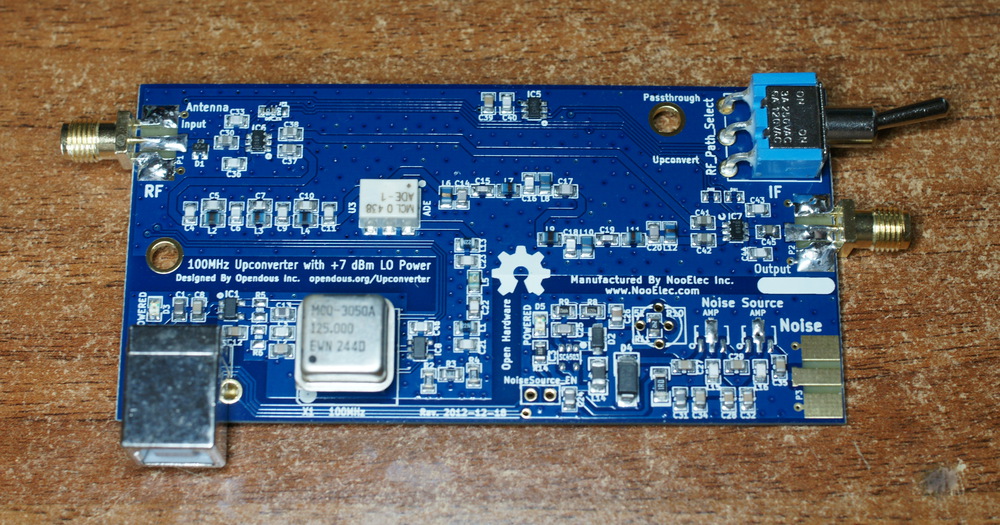Frequency Shift for SDR Radio - Ham it up v1.2 upconverter
 Some time ago I wrote about universal radio receivers for $ 20 from TV tuners on rtl2832. Their biggest drawback was that they could not accept anything below 50 MHz (e4000 - does not work below 50 MHz, R820T - below 24 MHz), and in this range - 3/4 of all interesting things that can be heard on the radio due to the fact that short waves are reflected from the ionosphere - and the communication range is no longer limited to direct visibility.
Some time ago I wrote about universal radio receivers for $ 20 from TV tuners on rtl2832. Their biggest drawback was that they could not accept anything below 50 MHz (e4000 - does not work below 50 MHz, R820T - below 24 MHz), and in this range - 3/4 of all interesting things that can be heard on the radio due to the fact that short waves are reflected from the ionosphere - and the communication range is no longer limited to direct visibility.You can eliminate this disadvantage by adding a frequency converter to it. It’s quite difficult and expensive to make a high-quality (with all filters) converter with your own hands, so you had to buy ready-made: Ham-it-up v1.2 with 125 MHz quartz ($ 42.95, from the USA it took a little longer than a month). Brief test results and a few tricks for successful reception on short waves - under the cut.
Converter itself

The principle of operation - we cut off everything above 50 MHz from the antenna signal, mix it with 125 MHz frequency obtained on a quartz oscillator, again filter out the excess from the signal - and get our signal shifted up by 125 MHz. Those. the fact that the antenna came at 10 MHz - in the receiver we will receive at a frequency of 135 MHz.
')
The choice of quartz at 125 MHz is very important, many converters use quartz at 100 MHz, and the received signal is received just around powerful FM stations, which can be a serious problem and you have to fence very neatly shielding absolutely everything.
This converter does not have a built-in amplifier, and the loss in converting is about 10dB (i.e., the signal becomes 10 times weaker). However, as it turned out, this is not a problem - there is so much noise on the air that the amplifier inside the RTL2832 never had to be turned to its maximum.
Trivial Tricks
I was tormented for a long time because of the poor quality of reception. As it turned out, many poorly-made electronic devices are shitting on the air and the electrical network just in the range of interest (0-50 MHz). In my case, the wildest interference (about 30-100 times more background) was from a tabletop LED lamp and an old LCD monitor (backlighting on cold cathode lamps). Also, do not keep the computer with the case open - it will also shine with interference.The computer should be grounded, some responded well to the use of laptops on battery power (to eliminate interference from the network)
An antenna for low frequencies is needed much larger in size than for ~ 433 MHz. I did it simply - I pulled 15m of copper wire from the balcony (a rough formula for estimating the required optimal length for a quarter-wave monopole antenna is 71250 mm / frequency in MHz (for 22AWG cable)).
And finally - at night you can hear much more than during the day - due to a change in the state of the ionosphere.
Listen
Mostly you can hear HF radio stations - at night we managed to listen to radio stations from France, Italy, Germany, Bulgaria, Great Britain and China (from about 7 to 13 MHz). Amateur transmitters - managed to catch only in Morse code. After a long search for optimal settings, I was able to hear the “Doomsday” radio station - UVB-76 : I was not lucky that the balcony faces south, and the station is north-west of Moscow.At 27 MHz you can hear less than I expected - only walkie-talkies that are relatively close to me (that is, in dialogs I often hear only one person). Apparently you need a more thorough approach to the design and coordination of the antenna.
Make the volume lower:
Good luck in the study of the ether :-)
Source: https://habr.com/ru/post/187946/
All Articles